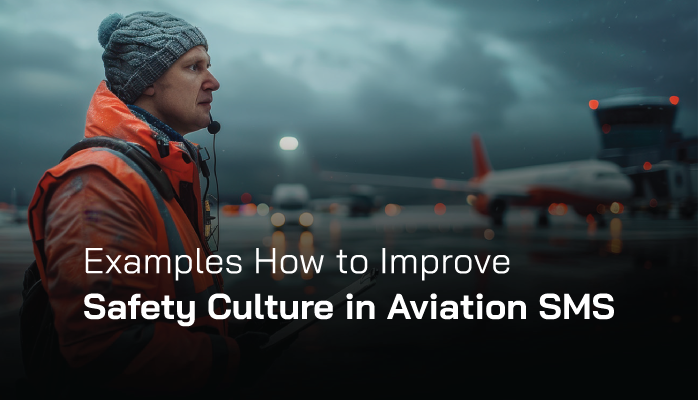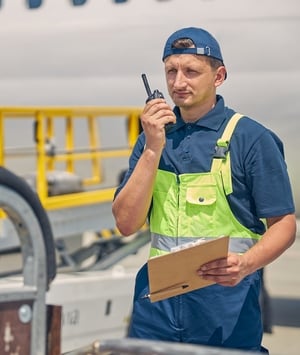What Is Safety Culture in Aviation SMS

“Safety culture” is an ambiguous phrase that gets thrown around a lot.
Sometimes we use it when we talk about poor safety awareness when employees behave ignorantly on the ramp or around dangerous situations.
Sometimes we use it when we talk about corporate culture or lack of upper management support whenever we see competing business priorities and demands taking precedence over safety concerns.
Sometimes we use it to refer to resistance to the safety program as employees stubbornly resist participating in the SMS, such as reporting safety concerns or attending safety meetings.
Safety culture can generally be broken down into the following 5 components:
- Hazard reporting culture;
- Safety awareness of all employees;
- Safety communication;
- Willingness; and
- Management-employee relationships.
There's a big difference between understanding what unhealthy safety culture looks like and actually improving safety culture. Managing a safety program with a poor safety culture will constantly make you feel like your hands are tied.
Related Articles on Aviation Safety Culture
- What Is Safety Culture in the Aviation Industry?
- What Does Aviation Safety Culture Look Like?
- Checklist for Proactive Safety Culture in Aviation SMS Programs [With Free Resources]
Safety culture correlates directly to safety performance. You might look at the role of safety culture in overall aviation safety as:
- Safety management systems design and document safety efforts;
- Safety managers use the safety program to influence safety culture;
- Safety attitudes and behaviors result in safety performance; and
- Safety performance feeds the safety decision-making process.
Understanding how to improve safety culture first involves understanding the components of safety culture and the role safety culture plays in aviation safety.
Symptoms of Poor Safety Culture
After understanding what safety culture is, the second step in improving safety culture is to be able to identify symptoms of poor safety culture in your aviation SMS. Here are some common signs of poor safety culture:
- Much lower than expected number of hazard reports;
- Appointed safety executive does not take responsibility for the safety program;
- Active resistance to the safety program;
- Number of high-risk safety incidents not improving over time (or getting worse);
- Number of workplace accidents not improving (or getting worse);
- Management silos;
- Lack of upper management support for safety program;
- Retaliation from managers or other employees against the person who reported safety issue;
- Strong tendency of employees or management to focus on "blame", or the person rather than the incident;
- Resistance to change;
- Lack of access to safety information;
- Lack of communication from safety management about important safety concerns;
- Lack of safety budget; and
- High number of repeat safety incidents.
This list goes on, but this should provide a solid foundation of some of the most common signs of an unhealthy safety culture. Do any of these points look familiar?
More Related Articles on Aviation Safety Culture
- How to Build Safety Culture in Aviation SMS
- 8 Charts to Monitor Safety Culture Performance in Safety Management Systems (SMS)
- How to Change Toxic Safety Cultures in Aviation SMS
Signs of an Effective Safety Culture

The last thing you need to firmly understand before starting to improve safety culture is what effective safety culture actually looks like. If you don't know this, you don't know what you are improving towards.
Here are some signs of an effective safety culture:
- Upper management support of the safety program;
- Financial investment in SMS tools;
- Dedication to prescribed safety behavior requirements;
- SMS has listed and distributed valued safety behavior;
- Has strong non-punitive reporting policy;
- Employees are involved in the change management process;
- Hazard reporting process that is easy to use, accessible, and actively used;
- Regular communication to employees concerning latest safety concerns;
- Safety training includes end of course assessments; and
- Safety culture is regularly evaluated, such as with safety surveys.
Once again, the list of signs of an effective safety culture goes on, but the above points provide a solid basis.
Related Articles on Improving Safety Culture in Aviation SMS
- Why Transparency Promotes Safety Culture in Aviation SMS
- 5 Ways to Constantly Improve Safety Culture
- Aviation Safety Cultures Improved With Integrated Safety and Quality Management Systems
Ways to Improve Hazard Reporting Culture
Hazard reporting culture is the first component of safety culture you should try and improve. Hazard reporting forms the basis of your data acquisition process and all subsequent risk management activities that are vital to aviation SMS. Moreover, of all components of safety culture, safety management has the most direct influence over hazard reporting.
Here are some inspiring examples to improve hazard reporting culture:
- Audit your hazard reporting process to assess whether it can be made easier or more available (i.e., ask employees how they would improve the process!);
- Train employees on hazard identification techniques;
- Create and distribute a list of mandatory reporting and voluntary reporting types of safety concerns;
- Include employee hazard reporting data in performance reviews; and
- Offer multiple ways to report hazards, such as via email, mobile device, online website, etc;
- Routinely discuss recently discovered hazards or existing hazards that could affect operations in safety meetings;
- Highlight the importance of hazard identification and safety reporting in safety newsletters;
- Reward employees who make significant contributions to identifying and reporting hazards;
- On employee badges, add a safety message with a URL to report safety concerns;
- Have accountable executive perform regular walk-around inspections with the safety manager to demonstrate top management commitment; and
- Create safety surveys with a significant bias toward hazard identification and reporting practices.
For safety management wondering how to improve safety culture, improving hazard reporting culture provides a major boost in overall safety culture.
Related Articles on Aviation Hazard Identification
- 4 Pillars | What Is Hazard Identification in Aviation SMS
- 4 Tips to Approach Hazard Identification in Aviation SMS
- From Reactive to Proactive Hazard Identification in Aviation SMS
Ways to Improve Employee Safety Awareness (Mindfulness)

Improving safety awareness is critical for developing a mature safety culture. Safety awareness is simply the ability to:
- Be mindful of the relationship between your actions, environment, and safety;
- You have a good understanding of past safety concerns; and
- You are up to date on the latest safety concerns.
As you can see, safety awareness is practically the same as situational awareness, which is a fancy term for employees being mindful of their surroundings. Since we are discussing aviation SMS, there will be a safety focus in this case that stresses awareness of:
- Hazards;
- Risk consequences related to hazards; and
- Risk controls and any necessary employee interaction with these controls, such as monitoring or having the ability to quickly react to an event using implemented risk controls.
Fortunately, there are several easy ways to influence safety awareness in SMS programs:
- Safety training and using end-of-course assessments;
- Regular communication with employees via
- Daily safety briefing
- Safety meetings
- Safety newsletters
- In person conversation
- Stress testing behavior and follow-up reviews, such as with Emergency Response Drills and follow-up meetings to discuss behavior during the drill.
Improving awareness is largely about helping employees understand the safety implications of their actions. When employees can see the personal connection between their attitude/behavior and their own personal safety, they are universally much more willing to comply and be involved with the SMS.
If you have been paying attention, you will notice that safety teams have many tools at their disposal to increase safety awareness. These are the same safety promotion tools used by safety managers to educate employees on the purpose and importance of SMS. Safety promotion can take many forms and target multiple objectives.
The most common "visible" safety promotion tool in the aviation industry is "safety newsletters." Unfortunately, we observe that MOST aviation service providers don't publish safety newsletters frequently enough to consistently remind employees of the need to be "aware of their surroundings." This lack of newsletter publishing frequency can be overcome using supplemental safety promotion techniques, such as
- shop banners,
- safety awareness posters,
- messages on the bulletin board; and
- regular line-employee safety meetings.
Related Aviation Safety Promotion Articles
- FAA Part 5 Compliance: Safety Promotion (The "Overlooked Pillar")
- Effective Safety Promotion the Informal Way for Aviation SMS
- Aviation SMS Surveys - an Often Neglected Safety Promotion Tool
Ways to Improve Safety Communication
Poor safety communication can and will ruin safety culture. To improve safety culture, you must have solid communication lines between:
- Employee-employee;
- Management-employee; and
- Management-management.
In other words, communication works across all levels of an organization. Safety communication is about:
- Quickly acquiring safety data;
- Having enough data to make safety decisions; and
- Quickly appraising individuals of safety concerns and changes.
Some good ways to quickly improve safety culture are:
- Ensure all hazard reporting forms have enough (but not too many) fields to capture relevant safety information;
- Hold daily safety briefings with all employees;
- Hold weekly safety meetings with management and/or employees;
- Send out monthly safety newsletter;
- Provide an anonymous way of communication between management and employees;
- Safety team should have many personal interactions with employees; and
- Frequent use of safety surveys.
These are all easy, documentable ways to improve safety communication. They only require a bit of front-end work and dedicated follow-up. Return on investment for improving safety communications is hard to determine, but one can easily envision an organization that has poor safety communication practices.
Related Articles on Safety Communications in Aviation SMS
- How to Be Compliant With Safety Communication in Aviation SMS
- Cultivating Teamwork and Communication in Aviation SMS
- 3 Essential Communication Techniques for Aviation Safety Managers
How to Break Down Silos and Corporate Culture
Breaking down silos and corporate culture is a tricky beast to tackle. Unfortunately, there are no quick tips or easy answers here. The reality is that in some situations, you may be entirely powerless to effect change.
That being said, here are some ways to try and break down silos and change corporate culture:
- Identity dependencies on individual people and implement new processes into SMS to shift dependency to system (i.e., dependency on process vs person);
- Interface with front-line employees as often as possible to become their spokesperson for management;
- Push hard to demonstrate financial benefits of SMS; and
- Document grounds for punitive action.
Final Thoughts on Improving Aviation Safety Cultures
There are no quick fixes for toxic safety cultures. Changing the course of your safety culture is more difficult than changing the course of a drifting oil tanker in a storm. Many months or years may be required to change attitudes and behaviors in your SMS.
At the opposite end of the spectrum, damaging a safety culture is easy and can be done very quickly if managers are not quick to spot and mitigate bad behaviors and substandard conditions.
As stated before, accountable executives are responsible for monitoring the performance of the SMS and rectifying any shortcomings. Safety culture is an important element for the success of EVERY SMS. Therefore, when there are problems with your safety culture, make sure your account executive is informed and aware of the long-term risk of "doing nothing."
Here are some resources that should help you improve the safety culture in your aviation SMS program:
Accountable executives are responsible for monitoring the performance of their SMS. Here is another very useful and free resource to download.
Last updated January 2025.









